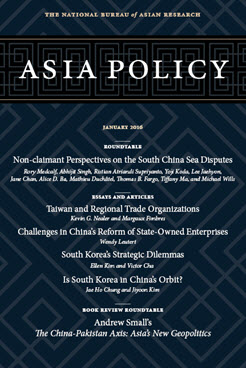Walking the Talk in the South China Sea
This essay is part of the roundtable “Non-claimant Perspectives on the South China Sea Disputes.”
For most of the first decade of the 21st century, the South China Sea was a region of relative calm. Civilian commerce and military transits and training were conducted with only routine concern for the security environment. After the Hainan Island EP-3 collision incident in 2001, peaceful development of the region’s resources moved forward until China re-promulgated a vague historical claim to much of the South China Sea in 2009—the so-called nine-dash line—which stoked tensions with its neighbors over competing sovereignty claims. Also worrying have been Beijing’s confrontational tactics: harassment at sea, the construction and garrisoning of artificial islands, and the absolute rejection of mediation or legal adjudication. These activities have tested, and frequently overstepped, the boundaries of international law.
This essay examines the core U.S. interests in the South China Sea and argues that the United States should ensure that freedom of navigation operations are one component of a consistent and comprehensive strategy of regional engagement. This strategy needs to make full use of well-honed diplomatic, military, and economic tools to impart a shared vision of a peaceful maritime arena.
Core U.S. Interests and Freedom of Navigation
The escalation of tensions in the South China Sea has tested the littoral states’ preferred strategic orientation: good relations with China, the United States, and their neighbors. More than ever, they fear that China’s pretensions are a preview of the day when Beijing will make all the rules and call all the shots in littoral Asia. In a number of respects, it is unfortunate that the U.S. pivot or rebalance to Asia was framed as such, implying that the United States had abandoned the region during the war on terrorism. As one of our good friends in the region once said to me, the rebalance is really a “reaffirmation” of U.S. policy and presence over the past three administrations. The facts are the United States has remained committed to Southeast Asia and engaged there because the challenge to peace in the South China Sea is also a challenge to three key U.S. interests.
The first and foremost reason the United States will remain invested in the peace and stability of Pacific Asia is economic. In 2014, U.S. exports to Asia had a total value of $650.5 billion, while imports from Asia were worth $1.06 trillion, accounting for a respective 27.7% and 37.2% of total U.S. exports and imports. [1] Further, investment by American entrepreneurs in Asian economies gives the United States a stake in the regular and uninterrupted conduct of intrastate and intraregional trade and in predictable and inclusive growth. A second national interest is the security of allies and friends. The pursuit of peace beyond U.S. shores is, in turn, the most effective guarantee that the continental homeland will never itself become a battlefield.
Third, both of these core interests—prosperity and security—are underpinned by the traditional rights of states to sail unimpeded on the high seas and, without impairing the peace or security of coastal states, travel through territorial waters without prior permission. From its earliest days, the law of the sea has protected trading nations’ access to foreign ports. In the modern global economy, all nations are traders and enjoy in common the benefits of open access. Further, maritime power, which is reliant on mobility at sea, plays a unique and irreplaceable role in U.S. power-projection strategies, being both flexible and visible. U.S. fleets make neighbors of our distant allies, assuring them of the United States’ commitment to their security. [2]
The U.S. Freedom of Navigation Program was established in response to the gradual erosion of traditional rights at sea. Rather than an attempt by the United States to claim special privileges, it was created in reaction to new claims to territorial zones that threatened to enclose the littoral space within a jumble of overlapping jurisdictions. [3] Announced in 1979 by President Jimmy Carter and endorsed by President Ronald Reagan in the 1983 U.S. Oceans Policy, the Freedom of Navigation Program has provided the auspices for U.S. Navy vessels to sail and operate in waters…
Endnotes
[1] “International Data: Table 2.3. U.S. International Trade in Goods by Area and Country, Not Seasonally Adjusted Detail,” Bureau of Economic Analysis, U.S. Department of Commerce, September 17, 2015; and “International Data: Table 2.3. U.S. Trade in Services, by Country or Affiliation and by Type of Service,” Bureau of Economic Analysis, U.S. Department of Commerce, October 15, 2015. Both sets of data are available at http://www.bea.gov/itable.
[2] Hedley Bull, “Sea Power and Political Influence,” Adelphi Papers 16, no. 122 (1976): 6.
[3] Elliot L. Richardson, “Power, Mobility and the Law of the Sea,” Foreign Affairs 58, no. 4 (1980): 904.
Thomas B. Fargo is the John M. Shalikashvili Chair for National Security Studies at The National Bureau of Asian Research. He served for 35 years in the U.S. Navy, which culminated in his position as Commander of U.S. Pacific Command from 2002 to 2005.
About Asia Policy
Asia Policy is a peer-reviewed scholarly journal presenting policy-relevant academic research on the Asia-Pacific that draws clear and concise conclusions useful to today’s policymakers. Asia Policy is published quarterly in January, April, July, and October and accepts submissions on a rolling basis. Learn more


